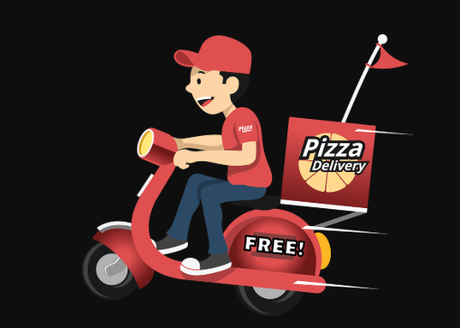The rise of on demand food delivery is one of the most significant developments to have happened in the era of mobile applications. But the concept of food delivery is nothing new. The first food delivery service is reported to have started in Korea in 1768!
While the Korean trailblazers only delivered naengmyeon (cold noodles) to their customers, modern food delivery companies cover everything from bite-sized street-food to gourmet three-course meals. Popular food delivery apps have come to include a wide array of cuisines over the years and brought about huge changes to the food industry.
1] How food delivery apps changed the world we live in
On demand food delivery started as a service offered only by the food makers - restaurants, bakers and pizzerias. The rise of mobile app technology gave innovative thinkers the tools they had been lacking. The result - companies like Uber Eats making it big simply delivering food.
You no longer need to be a maker of food items to get into the industry and make it big. With a good mobile app for platform, simply creating a good network and efficient flow between the involved parties spells booming business.
Another manner that mobile apps altered the food business is by creating room for newer and smaller players. The days of talented chefs and food connoisseurs giving up on their dreams of starting own businesses are long past.
Lack of funding and space isn't stopping those interested in the food industry from taking the leap these days. On the contrary, these upstarts are using mobile app technology to operate on a strikingly smaller budget than conventional food joints.
Cloud kitchens - Shared cooking spaces where food is prepared on-demand for the sole purpose of delivery have disrupted the traditional 'dine-in' and 'take-away' ways of old-school eateries.
And now we have Dark kitchens coming up all over the world, delivering delicacies to locations where its hard to open a restaurant due to financial or spatial reasons. These delivery-only food makers are using popular food delivery apps to propel their business and offer diverse, better priced food choices to the consumers.
Led by new-age mobile apps, the global online food delivery services are expected to be worth $200 billion by the year 2025. The future of on demand food delivery apps is definitely bright, but what changes can we expect to see in them in the coming years? Let's find out.
2] Increased focus on brand recognition via customization
One of the factors that made a household name around the world was their on-demand food delivery service. And that was long before mobile apps became a thing. Present day food delivery apps have somewhat mitigated the pull of brand name.
While app interface is filled with well-known logos and elaborate menus people have come to love and recognize, the wide range of lesser known and totally unknown food delivery outlets on the apps, together with the discounts and offers have the effect of diverting people's focus from the bigger brands.
These days, wanting to order a pizza means unlocking your mobile device and opening your favorite food delivery app. But even if your first thought was Pizza Hut, the number of different options on screen, along with the numerous offers can sway your attention in no time.
The result - you're quite likely to check out the menu from a different pizzeria just to see what all is on it. You're also highly likely to order from a source other than Pizza Hut either for want of trying out something new or because they have some great deals going on on that particular day.
Food brands want this situation remedied and are pushing for better branding practices to create and maintain a distinct identity on mobile apps crowded with choices.
Food delivery apps like GrubHub, Zomato and (Check how it works) Uber Eats already allow the vendors a good deal of customization in their in-app profiles. This trend is likely to grow in the future, with more vendors putting in the effort to customize their pages to match their theme and highlight their specialties and USPs.
Expect delivery apps to offer greater degree of customization so new businesses can build up their brand and big names can use brand recognition to draw in more business.
is one of the few food delivery apps that currently feature real time update of food menus. Imagine selecting a food item from the online menu only to be informed it's not available moments later. Few things can be more off-putting!
Mobile apps allowing vendors to make instant changes to the menu, adding or removing food products, even putting out discounts and changing pricing is likely to become a regular feature in days to come.

Food outlets with dine-in facility are most likely to benefit from this upgrade as it will ease the pressure on the staff and prevent the chances of mix-ups when several of the staff are working on the same order.
4] Improved prediction, recommendation and personalization
AI is making long, rapid strides and on-demand food delivery is yet another aspect of modern lives where it's expected to bring big changes.
The majority of popular mobile apps that people use for ordering food have rather basic predictions. These are often limited to the choice of frequently favored vendors and repeating past orders. This is likely to change big time, and soon!
With the world's top mobile app developers utilizing AI in their creations to boost ease of operation and efficiency, future food delivery apps are set to become smarter and more intuitive than ever. They will be able to factor in the day of the week and the time of the day to predict the vendor and food items a person is likely to order.
Much like the 'recommendations' or 'suggested listening' feature of music streaming apps like and Apple Music, food lovers can expect the mobile apps to recommend new foods they are likely to enjoy.
Same as food vendors, customers, too, will love and benefit from better personalization as the act of ordering food becomes a faster process that involves much less searching around.
5] Subconscious menus and placing orders with a glance
Back in 2014, Pizza Hut made the headlines with its subconscious menu. The software tracked the customer's eye movements and selected toppings that the customer happened to be looking at the longest. The technology has come a long distance in the years since and is sure to become a regular feature of on-demand food delivery apps in the near future. Present day eye tracking sensors have crazy precision.
Just like Pizza Hut's subconscious menu, the apps' built-in software calibrates according to the customer's eye movement and selects the choices the eyes rest upon the longest. It then proposes an order and follows through if the customer approves.
The placing of the order, again, can be achieved simply by glancing at the Place Order button. Looking at Restart will cancel the present order so the customer can begin building the order afresh.
6] A bigger role for Big Data analytics
With the ever-increasing competition and technological changes, mobile app developers are turning to Big Data analytics to make the apps more adept at serving the needs of the customers, vendors, as well as the food delivery agents.
Analyzing a vast range of data sets, including customers' order histories, traffic and weather conditions and stock availability can offer businesses new insights into customers' food preferences on a given day.
Developers are using Big data to create apps that are more customer driven and that help improve the businesses' understanding of customer behavior and habits.
With Big data analytics playing a bigger role, food delivery apps will be able to better predict the demand and delivery time. This will also make ordering and delivery processes more efficient while Improving customer service, as also, the customer experience.
We live in a world where the clocks seem to be ticking faster and trends are subject to change without the slightest warning. Food delivery mobile apps have revolutionized everything from the way people access food and plan their meals to how the global food industry operates. And the apps haven't stopped evolving!

